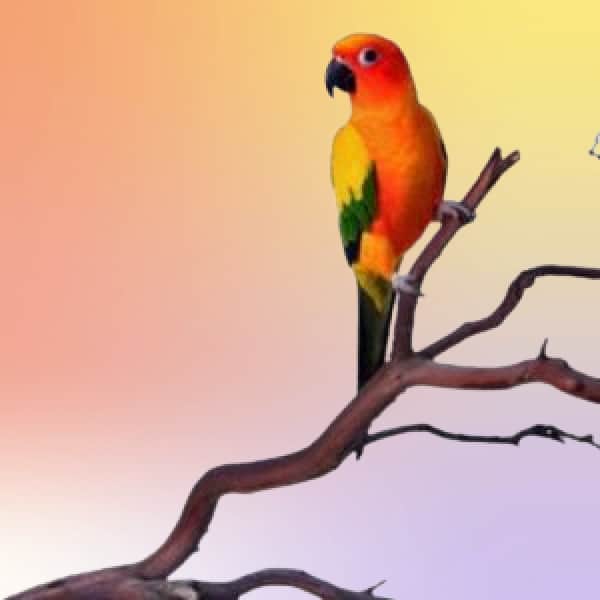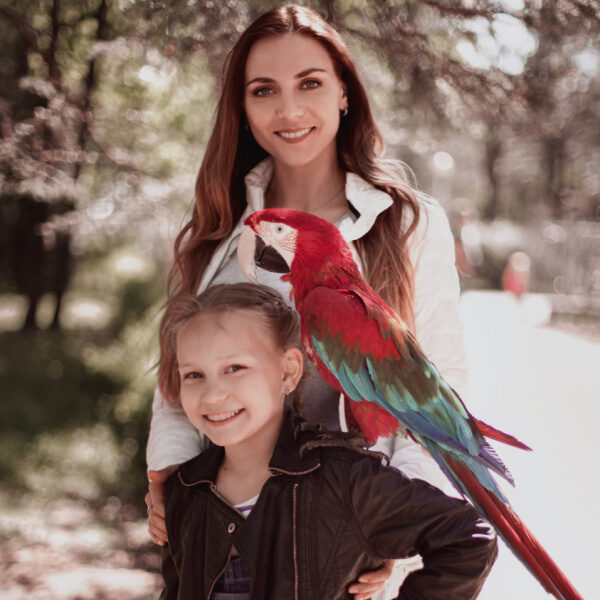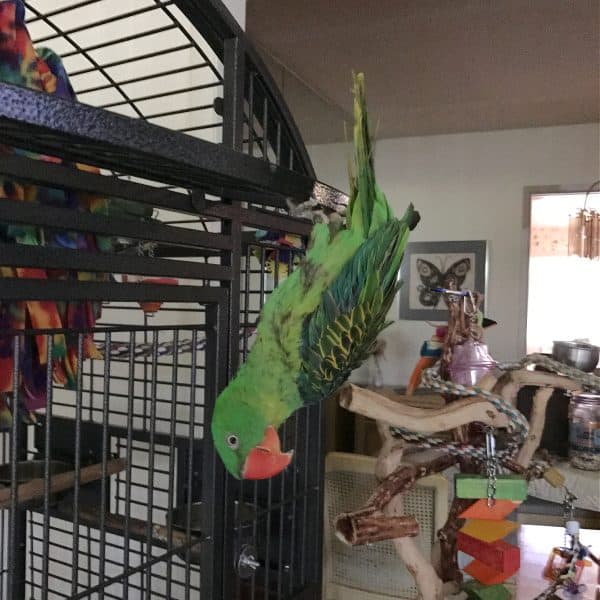Last Updated on by Mitch Rezman
Its natural bumps, turns and uneven surface is great for your bird’s feet. It cleans easily and it lasts a long time, unlike many of the items your feathered companion comes in contact with 🙂 The irregular but fairly smooth surface helps exercise your bird’s feet while providing little tidbits of interest with different knots & knurls that are found along the perch.
Our Manzanita perches are kiln dried. The kiln drying will help these perches withstand prolonged use and reduce the possibility of cracks. We offer Manzanita perches in the natural color of reddish brown or a sandblasted creamy white which has a bit of a coarser surface texture for a better grip. Natural Manzanita has a smoother surface but looks darker. Birds that have trouble gripping like Eclectus, are better suited to Sandblasted Manzanita. Currently all our large Manzanita perches are sandblasted.
What size is right for your bird?
Generally speaking, a good bird perch allows a bird to wrap it’s feet around without the front toes touching the back toes. Perches should not be all the same size in the cage or on a stand.
We used to offer “guide lines” as to the proper size perches for a particular species but the more we got granular the less it made sense.
Please read: Does the plethora of parrot perches produce puzzlement? Learn perches & placement now!
Remember, these are natural branches. Diameters will vary from one end to the other end of every single perch – once again good for the bird.
What if my Manzanita bird perch develops cracks?
The amount of cracking depends on how its harvested and processed. Our vendor slits each branch as soon as he harvests it. This allows the piece to expand naturally, from-the-inside-out with less splitting.
Kiln drying further reduces the splitting. Sandblasted perches crack less than ones with the natural dark skin. Cracks are not harmful though and can provide. additional interest for your bird. Cracks offer a great way for your bird to trim their own beak.
If your Manzanita perch develops a long crack simply rotate the perch so the crack faces down, this will keep debris from accumulating inside the crack. That said, the Manzanita bird perches we sell are natural plants complete with natural imperfections like bumps and cracks.
The good news is, all these “imperfections” actually make each piece more interesting to your bird. More bumps make your birds feet work more – a good thing.
Why is the bark peeling?
Live Manzanita will shed it’s bark or “skin” for 3 or 4 days a couple of times a year. If your bark is peeling, that piece was harvested during that brief regeneration period. The good news is it’s more for your bird to pick at and play with and won’t be as slippery.
What exactly is Manzanita?
Manzanita is an evergreen bush or small tree found in western North America. from British Columbia in Canada to California, New Mexico & down to Central Mexico
A unique shrub, smooth, orange, red or brown bark and stiff with twisting branches. You may be surprised to learn there’s about 60 species. Manzanita is a close-to-the-ground species found coastally. The mountainous variety is where you’ll see small trees of up to 6 feet. Manzanitas bloom from winter to early spring. Their berries and flowers are edible.
The company we get our Manzanita from does not sell any protected varieties of Manzanita and gets it only from land owned by private individuals.
As bird people we see this as a terrific means of providing a resting or climbing place for your birds but Manzanita berries can be dried and ground into a coarse meal.
Refreshing cider can be made from soaking fresh berries and branch tips. You can even quell a nauseous stomach with bark that has curled off and boiled into tea.
You can burn it in a campfire or a wood burring stove. You can barbecue with it but with caution because it burns so hot it can damage thin-wall grilles
Dead Manzanita decays slowly and lasts for years making it ideal for parrot perches. Over time, sunlight will bleach and smooth it to a light grey or even white. You can even use it in your aquarium, it’s chemically neutral & resistant to the leaching of tannins. Just weigh it down or soak it for a while because its really buoyant.
Your Manzanita bird perch questions answered
Why is Manzanita so great for parrot perches?
It’s natural bumps, turns and uneven surface is great for your bird’s feet. It cleans easily and it lasts along time, unlike many of the items your feathered companion comes in contact with 🙂
All perches don’t have to go from one side of the cage to another. A single bolt perch lets you put the perch anywhere on the cage, inside or out
What size is right for your bird?
Remember, these are natural braches. Diameters will vary from one end to the other end of every single perch – once again good for the bird.
Why do we put so much emphasis on bird perches? Your parrot or small bird is it’s feet 24/7.
Their feet need constant stimulation to stay healthy. Every cage for a large parrot should have at least 3 perches of different surface. The hardwood dowel bird perch that came with your parrot cage, a Manzanita perch, and a rope perch for sleeping.
Author Profile
Latest entries
 The Traveling BirdJune 26, 2025Can You Name 5 Parrot Species That Are Living Wild in the USA?
The Traveling BirdJune 26, 2025Can You Name 5 Parrot Species That Are Living Wild in the USA? Bird BehaviorJune 26, 2025How is it Parrots Are Problem Solvers Social Animals and Even Use Tools?
Bird BehaviorJune 26, 2025How is it Parrots Are Problem Solvers Social Animals and Even Use Tools? Bird & Parrot AnatomyJune 25, 2025How a Tiny Chemical Modification Makes Parrots Nature’s Living Paintings
Bird & Parrot AnatomyJune 25, 2025How a Tiny Chemical Modification Makes Parrots Nature’s Living Paintings PigeonsJune 20, 2025How Do Parrots Thrive in Cities Outside Their Native Habitats?
PigeonsJune 20, 2025How Do Parrots Thrive in Cities Outside Their Native Habitats?




